Inversion Techniques on Etna’s Volcanic Emissions and the Impact of Aeolus on Quantitative Dispersion Modeling †
Abstract
:1. Introduction
2. Etna Volcanic Eruption on 12 March–14 March 2021
3. Methods
3.1. FLEXPART-WRF Model Setup
3.2. PollyXT Lidar Ground-Based Observations
3.3. Inversion Method
4. Results
Author Contributions
Funding
Institutional Review Board Statement
Informed Consent Statement
Data Availability Statement
Acknowledgments
Conflicts of Interest
References
- Stohl, A.; Prata, A.J.; Eckhardt, S.; Clarisse, L.; Durant, A.; Henne, S.; Kristiansen, N.I.; Minikin, A.; Schumann, U.; Seibert, P.; et al. Determination of Time- and Height-Resolved Volcanic Ash Emissions and Their Use for Quantitative Ash Dispersion Modeling: The 2010 Eyjafjallajökull Eruption. Atmos. Chem. Phys. 2011, 11, 4333–4351. [Google Scholar] [CrossRef]
- Kristiansen, N.I.; Stohl, A.; Prata, A.J.; Bukowiecki, N.; Dacre, H.; Eckhardt, S.; Henne, S.; Hort, M.C.; Johnson, B.T.; Marenco, F.; et al. Performance Assessment of a Volcanic Ash Transport Model Mini-Ensemble Used for Inverse Modeling of the 2010 Eyjafjallajkull Eruption. J. Geophys. Res. Atmos. 2012, 117, 1–25. [Google Scholar] [CrossRef]
- Kampouri, A.; Amiridis, V.; Solomos, S.; Gialitaki, A.; Marinou, E.; Spyrou, C.; Georgoulias, A.K.; Akritidis, D.; Papagiannopoulos, N.; Mona, L.; et al. Investigation of Volcanic Emissions in the Mediterranean: “The Etna–Antikythera Connection”. Atmosphere 2021, 12, 40. [Google Scholar] [CrossRef]
- Moxnes, E.D.; Kristiansen, N.I.; Stohl, A.; Clarisse, L.; Durant, A.; Weber, K.; Vogel, A. Separation of Ash and Sulfur Dioxide during the 2011 Grímsvötn Eruption. J. Geophys. Res. Atmos. 2014, 119, 7477–7501. [Google Scholar] [CrossRef]
- Stohl, A.; Forster, C.; Frank, A.; Seibert, P.; Wotawa, G. Technical Note: The Lagrangian Particle Dispersion Model FLEXPART Version 6.2. Atmos. Chem. Phys. 2005, 5, 2461–2474. [Google Scholar] [CrossRef]
- Brioude, J.; Arnold, D.; Stohl, A.; Cassiani, M.; Morton, D.; Seibert, P.; Angevine, W.; Evan, S.; Dingwell, A.; Fast, J.D.; et al. The Lagrangian Particle Dispersion Model FLEXPART-WRF Version 3.1. Geosci. Model Dev. 2013, 6, 1889–1904. [Google Scholar] [CrossRef]
- Pisso, I.; Sollum, E.; Grythe, H.; Kristiansen, N.I.; Cassiani, M.; Eckhardt, S.; Arnold, D.; Morton, D.; Thompson, R.L.; Groot Zwaaftink, C.D.; et al. The Lagrangian Particle Dispersion Model FLEXPART Version 10.4. Geosci. Model Dev. 2019, 12, 4955–4997. [Google Scholar] [CrossRef]
- Amiridis, V.; Kampouri, A.; Gkikas, A.; Misios, S.; Gialitaki, A.; Marinou, E.; Rennie, M.; Benedetti, A.; Solomos, S.; Zanis, P.; et al. Aeolus Winds Impact on Volcanic Ash Early Warning Systems for Aviation. Sci. Rep. 2023, 13, 7531. [Google Scholar] [CrossRef] [PubMed]
- Scollo, S.; Prestifilippo, M.; Bonadonna, C.; Cioni, R.; Corradini, S.; Degruyter, W.; Rossi, E.; Silvestri, M.; Biale, E.; Carparelli, G.; et al. Near-Real-Time Tephra Fallout Assessment at Mt. Etna, Italy. Remote Sens. 2019, 11, 2987. [Google Scholar] [CrossRef]
- Skamarock, W.C.; Klemp, J.B.; Dudhia, J.; Gill, D.O.; Zhiquan, L.; Berner, J.; Wang, W.; Powers, J.G.; Duda, M.G.; Barker, D.M.; et al. A Description of the Advanced Research WRF Model Version 4; NCAR Technical Note; NCAR: Boulder, CO, USA, 2019. [Google Scholar]
- ECMWF. ECMWF Starts Assimilating Aeolus Wind Data. Available online: https://apps.ecmwf.int/mars-catalogue/?class=rd&expver=hkv (accessed on 2 December 2022).
- Stoffelen, A.; Marseille, G.J.; Bouttier, F.; Vasiljevic, D.; de Haan, S.; Cardinali, C. ADM-Aeolus Doppler Wind Lidar Observing System Simulation Experiment. Q. J. R. Meteorol. Soc. 2006, 132, 1927–1947. [Google Scholar] [CrossRef]
- Engelmann, R.; Kanitz, T.; Baars, H.; Heese, B.; Althausen, D.; Skupin, A.; Wandinger, U.; Komppula, M.; Stachlewska, I.S.; Amiridis, V.; et al. The Automated Multiwavelength Raman Polarization and Water-Vapor Lidar PollyXT: The Next Generation. Atmos. Meas. Tech. 2016, 9, 1767–1784. [Google Scholar] [CrossRef]
- Baars, H.; Seifert, P.; Engelmann, R.; Wandinger, U. Target Categorization of Aerosol and Clouds by Continuous Multiwavelength-Polarization Lidar Measurements. Atmos. Meas. Tech. 2017, 10, 3175–3201. [Google Scholar] [CrossRef]
- Ansmann, A.; Seifert, P.; Tesche, M.; Wandinger, U. Profiling of Fine and Coarse Particle Mass: Case Studies of Saharan Dust and Eyjafjallajökull/Grimsvötn Volcanic Plumes. Atmos. Chem. Phys. 2012, 12, 9399–9415. [Google Scholar] [CrossRef]
- Mamouri, R.E.; Ansmann, A. Potential of Polarization/Raman Lidar to Separate Fine Dust, Coarse Dust, Maritime, and Anthropogenic Aerosol Profiles. Atmos. Meas. Tech. 2017, 10, 3403–3427. [Google Scholar] [CrossRef]
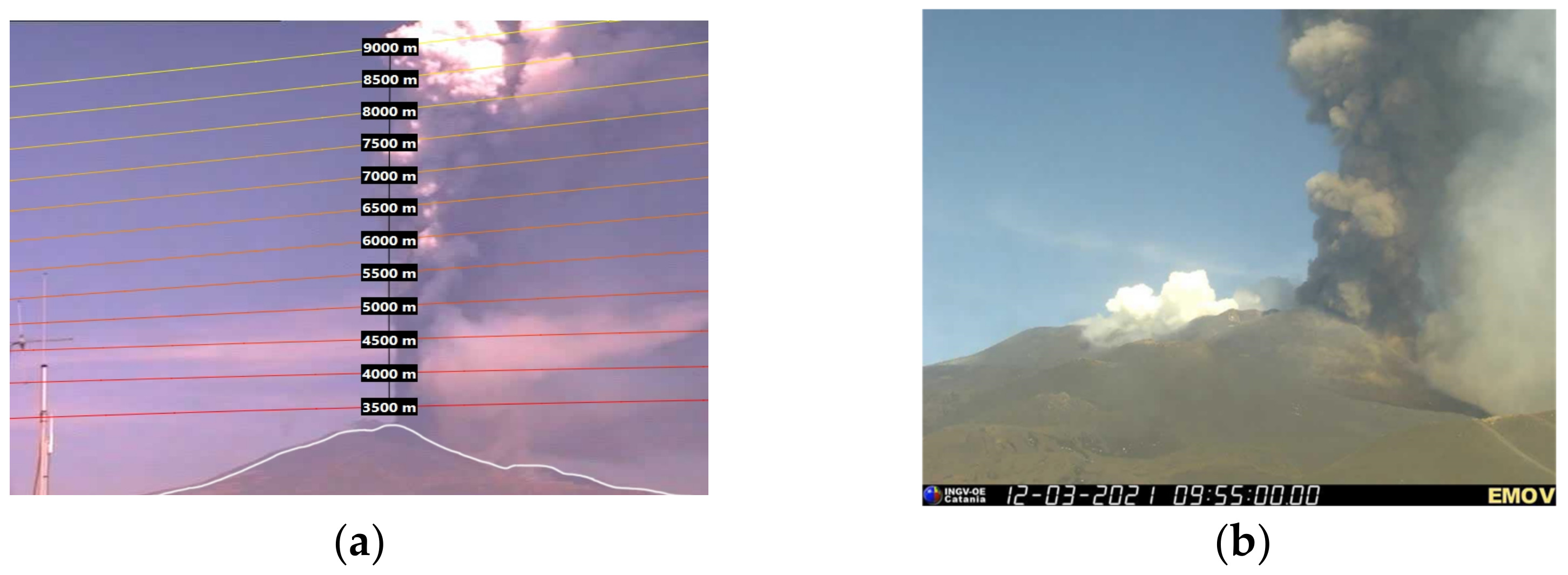
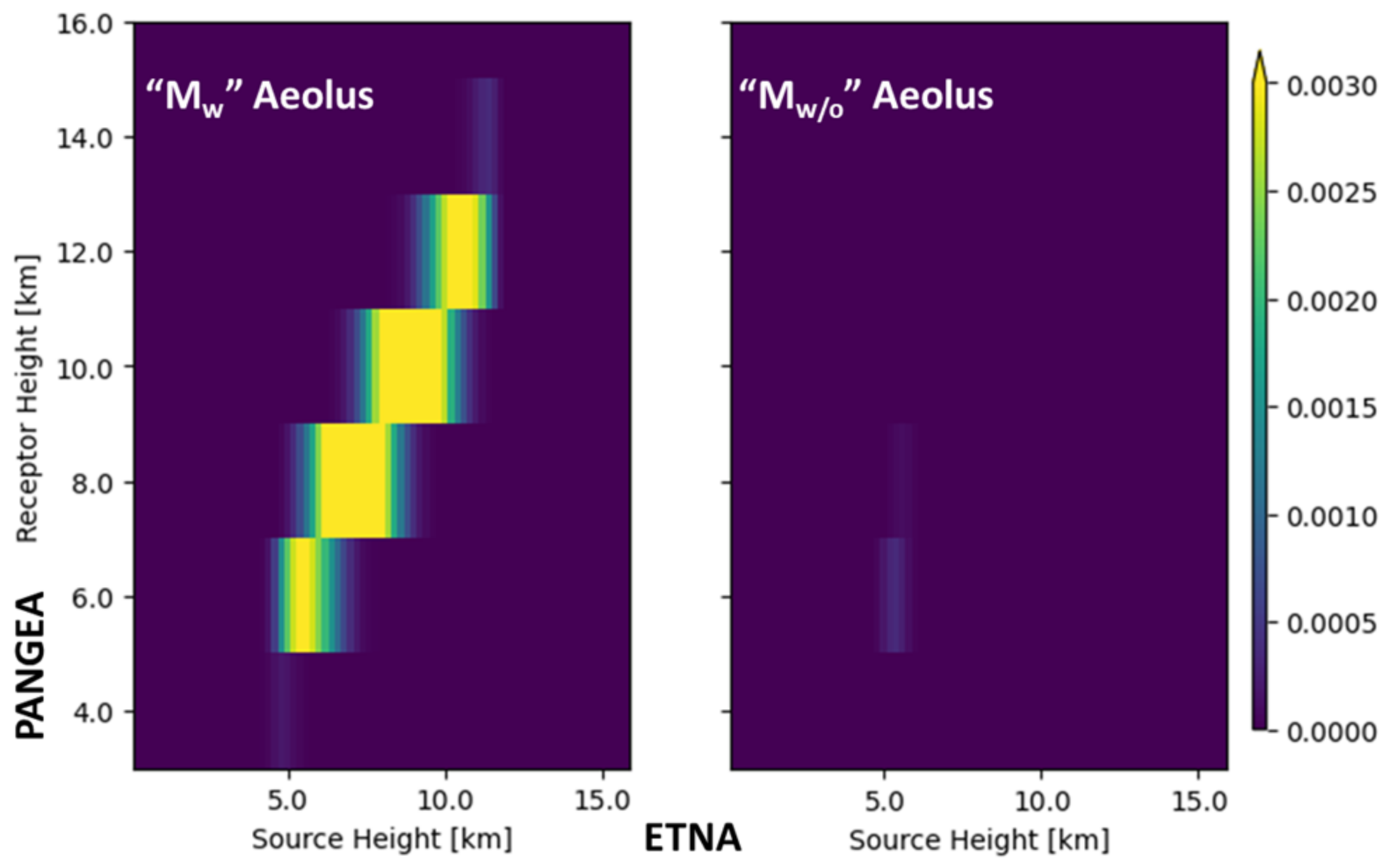
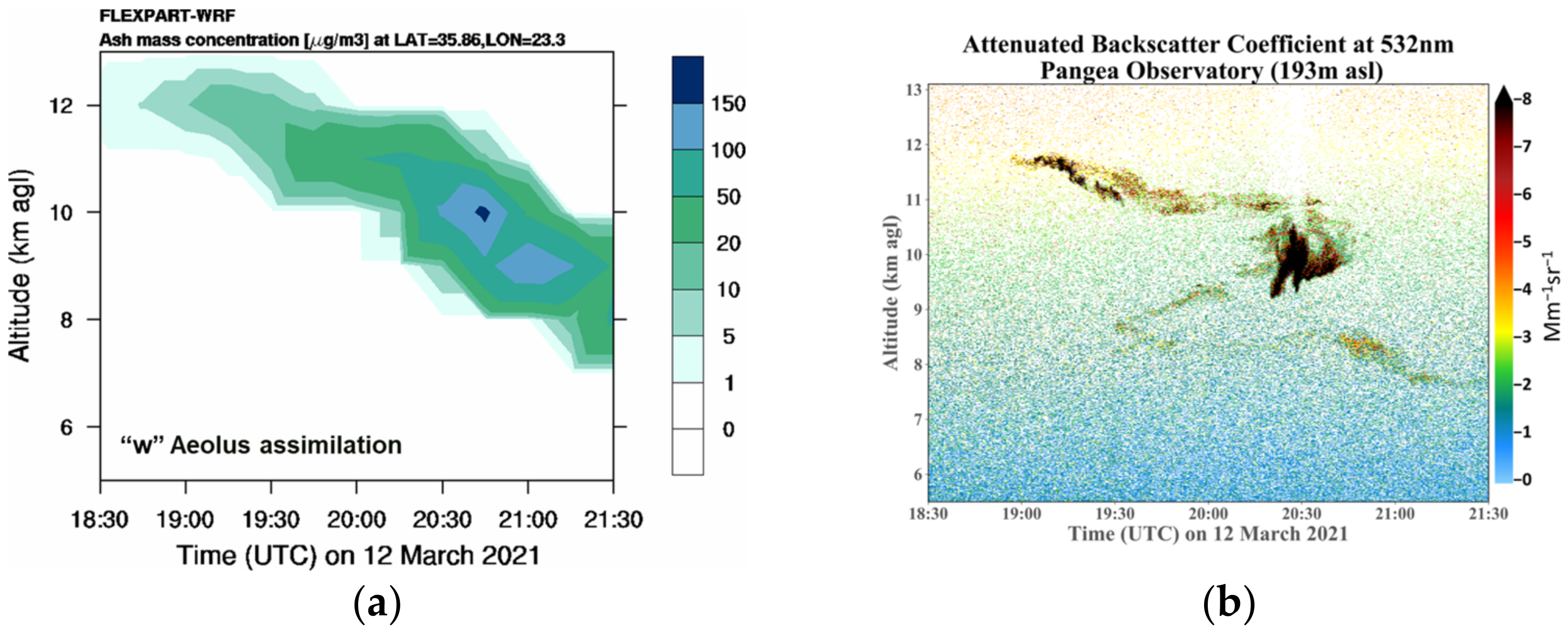
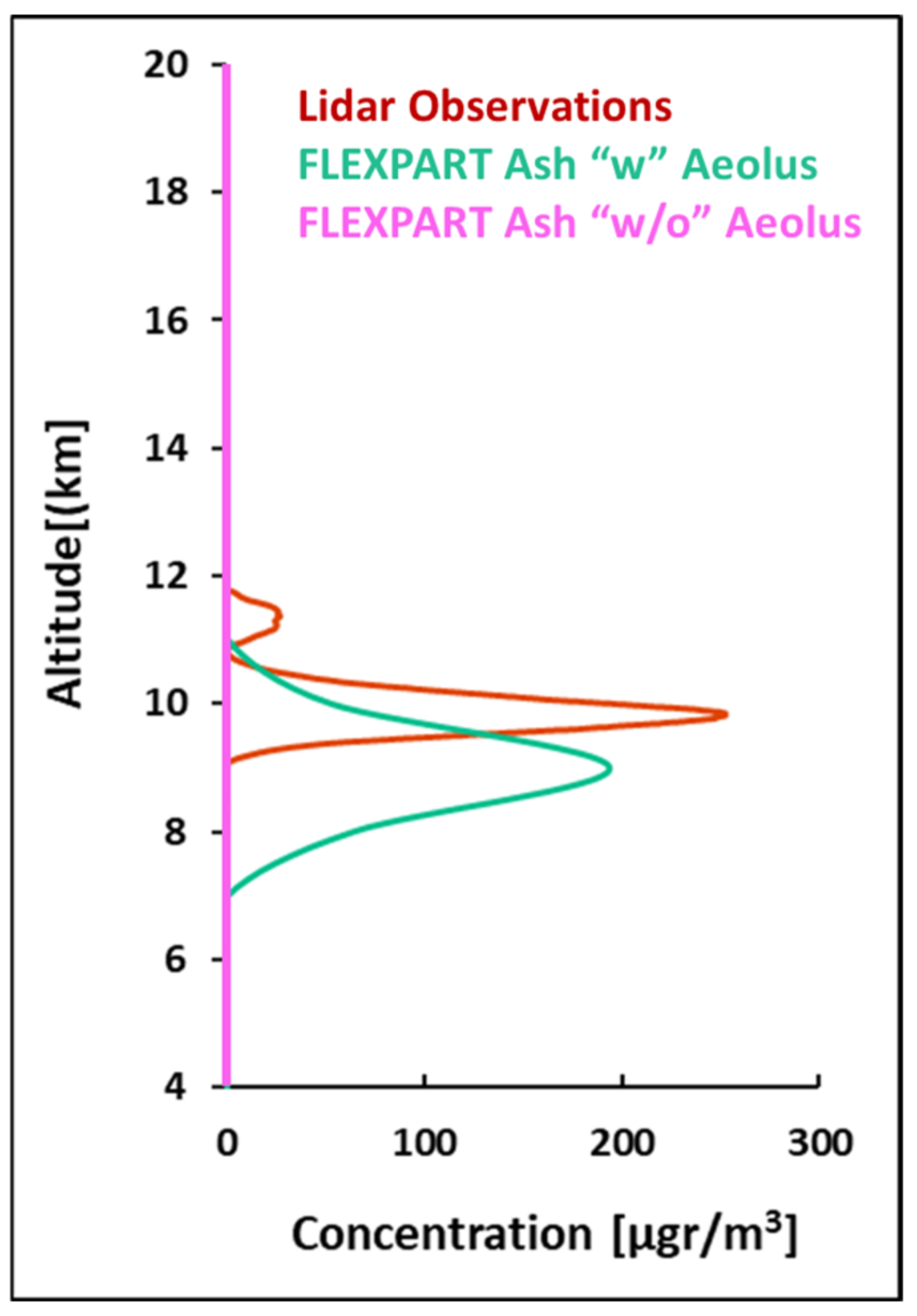
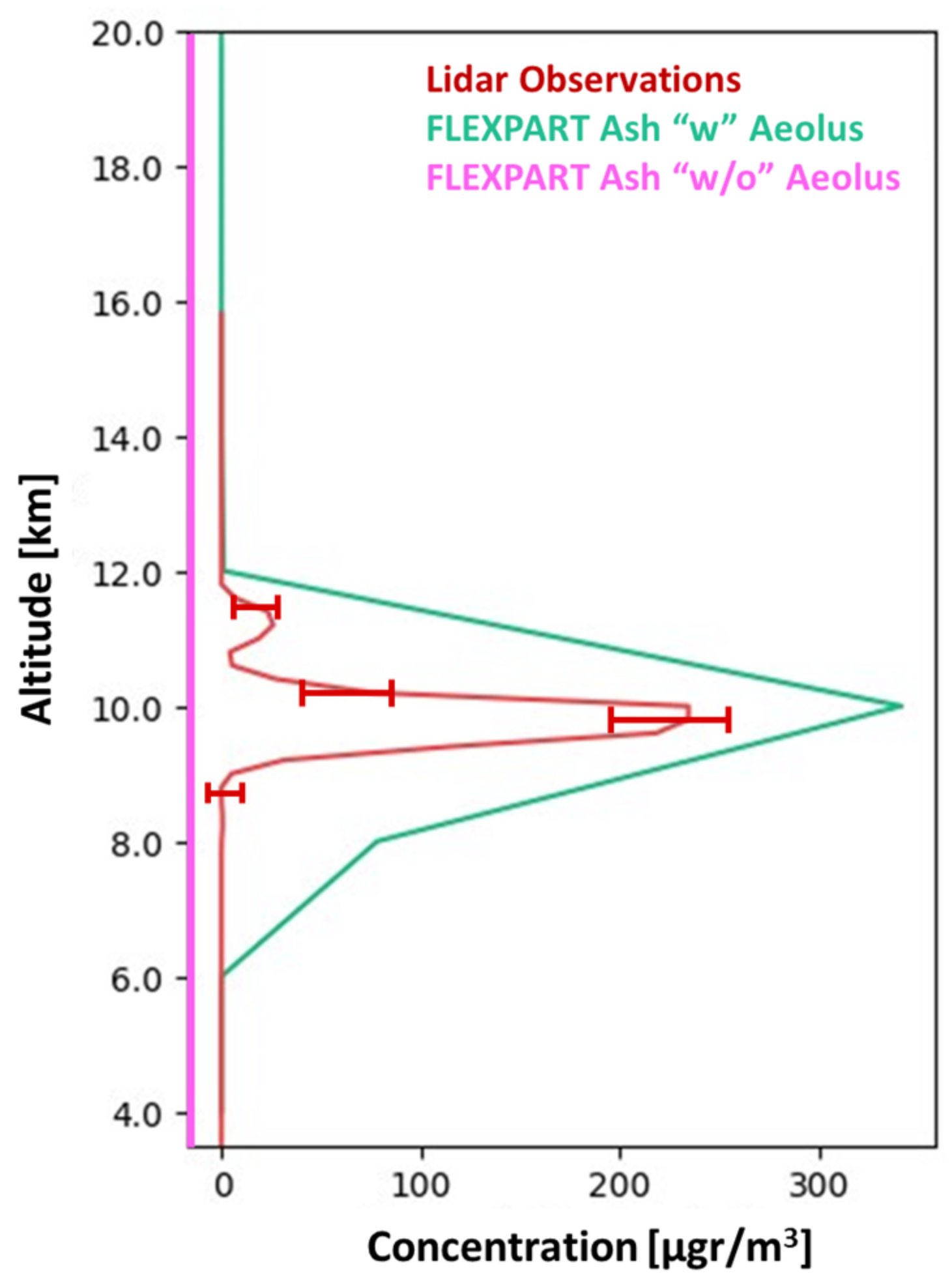
Disclaimer/Publisher’s Note: The statements, opinions and data contained in all publications are solely those of the individual author(s) and contributor(s) and not of MDPI and/or the editor(s). MDPI and/or the editor(s) disclaim responsibility for any injury to people or property resulting from any ideas, methods, instructions or products referred to in the content. |
© 2023 by the authors. Licensee MDPI, Basel, Switzerland. This article is an open access article distributed under the terms and conditions of the Creative Commons Attribution (CC BY) license (https://creativecommons.org/licenses/by/4.0/).
Share and Cite
Kampouri, A.; Amiridis, V.; Georgiou, T.; Solomos, S.; Binietoglou, I.; Gialitaki, A.; Marinou, E.; Gkikas, A.; Proestakis, E.; Rennie, M.; et al. Inversion Techniques on Etna’s Volcanic Emissions and the Impact of Aeolus on Quantitative Dispersion Modeling. Environ. Sci. Proc. 2023, 26, 187. https://doi.org/10.3390/environsciproc2023026187
Kampouri A, Amiridis V, Georgiou T, Solomos S, Binietoglou I, Gialitaki A, Marinou E, Gkikas A, Proestakis E, Rennie M, et al. Inversion Techniques on Etna’s Volcanic Emissions and the Impact of Aeolus on Quantitative Dispersion Modeling. Environmental Sciences Proceedings. 2023; 26(1):187. https://doi.org/10.3390/environsciproc2023026187
Chicago/Turabian StyleKampouri, Anna, Vassilis Amiridis, Thanasis Georgiou, Stavros Solomos, Ioannis Binietoglou, Anna Gialitaki, Eleni Marinou, Antonis Gkikas, Emmanouil Proestakis, Michael Rennie, and et al. 2023. "Inversion Techniques on Etna’s Volcanic Emissions and the Impact of Aeolus on Quantitative Dispersion Modeling" Environmental Sciences Proceedings 26, no. 1: 187. https://doi.org/10.3390/environsciproc2023026187
APA StyleKampouri, A., Amiridis, V., Georgiou, T., Solomos, S., Binietoglou, I., Gialitaki, A., Marinou, E., Gkikas, A., Proestakis, E., Rennie, M., Benedetti, A., Scollo, S., Mona, L., Papagiannopoulos, N., & Zanis, P. (2023). Inversion Techniques on Etna’s Volcanic Emissions and the Impact of Aeolus on Quantitative Dispersion Modeling. Environmental Sciences Proceedings, 26(1), 187. https://doi.org/10.3390/environsciproc2023026187








